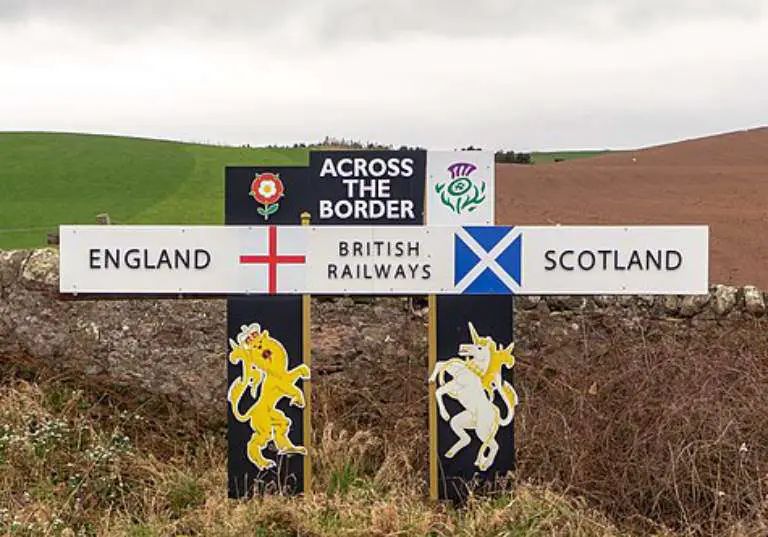The Scottish Borders
When it comes to popular tourism destinations, the Borders is Scotland’s greatest underdog. As the name suggests, the region claims part of the border between Scotland and England, a dramatic section of east coast between England and East Lothian, and lots of rolling rural landscapes, historic towns and pretty villages in between.
While The Borders’ position on the map, south of Edinburgh, means that it is very easy to reach from the city, the region is still often overlooked by visitors who naturally gravitate towards the Highlands.
Due to the Scottish Borders close proximity to England, the Scottish Borders has some of Scotland’s best history and war torn castles of yonder year. If like us you like to walk in the footsteps of your ancestors then the Scottish Borders is a fantastic place to start. The castles and forts around these areas have saw far more real historic action compared to those in the Highlands. So much action in fact that many are no longer visible due to the fierce battles the Scottish Borders and surrounding areas have witnessed over the years. We hope this post will encourage and inspire you to discover these beautiful Borders towns and villages.

THE SCOTTISH BORDERS BY PUBLIC TRANSPORT
All of the towns and villages are accessible on public transport, thanks to the excellent bus and rail connections.
- Borders Railway – reopened in 2015 along the same historic line which closed in 1969, this scenic railway route provides a direct connection with Edinburgh and the Scottish Borders. I recommend travelling to Galashiels (52 minutes) and crossing the road over to the bus station for onward connections to Melrose, Jedburgh and Kelso. Book in advance on TheTrainLine app for mobile eTickets or purchase set fare tickets at the station on the day.
- Borders Buses– this excellent local bus service is frequent and reliable, covering a wide network of towns and villages in the Borders. The buses accept contactless card payments or you can download the app. to plan your journey and purchase tickets in advance.
- LNER – for the Berwickshire Coast, take the LNER service towards London and get off in Berwick Upon Tweed for the short bus journey back across the border into Scotland. Again, plan your journey and buy tickets on TheTrainLine app. From May 2022 (all going to plan) a new station in the Borders village of Reston will be opening, which should provide better connections to the coast.

BORDERS TOWNS AND VILLAGES: TRAVEL INSPIRATION
JEDBURGH
Just 10-miles north of the border, Jedburgh has seen its fair share of conflict between the two countries over the centuries, from ruthless raids to full-blown battles. Today, it is a peaceful wee pocket of the Borders with lovely shops, cafes and riverside walks.
Jedburgh is often considered a pretty pitstop for those travelling between Scotland and England, but there is a surprisingly large number of significant historic attractions packed into the compact town centre, so a flying visit simply won’t suffice.
TOP THINGS TO DO IN JEDBURGH
VISIT: the 19th century Jedburgh Castle Jail and Museum, the stunning Jedburgh Abbey and Mary Queen of Scots Visitor Centre for an insight into Mary’s colourful life and demise, told through various displays in the historic house she stayed in during her visit to the town in 1566.
EAT: Naked Sourdough for incredible bakes, beautiful brunches and a lovely team of ladies.
WALK: Take a leisurely stroll along the River Jed or download the Paths Around Jedburgh booklet for more ideas.
Public transport to Jedburgh
- Take the train from Edinburgh to Galashiels and then the bus to Jedburgh.
- Jedburgh has direct bus connections to Melrose and Kelso.

DUNS
Duns is a small market town with a big claim to fame. Formula One legend and World Champion Jim Clark grew up on a farm near Duns, and though the sport sadly claimed his life aged just 32, he has left a strong legacy in the town and the wider area. The quaint Market Square is a reminder of times gone by, when the weekly markets were swarming with people and livestock.
TOP THINGS TO DO IN DUNS
CLIMB: Duns Law – a short and easy walk with lovely views, passing the remnants of an Iron Age hill fort and a more recent addition from the 17th century.
VISIT: Jim Clark Motorsport Museum– learn all about Jim Clark in this modern new museum dedicated to his life and career. The displays include racing cars, trophies, fantastic photographs and audio recordings with personal stories told by the people who knew him.
EAT: Jim Clark Bistro – both the museum and the bistro are managed by the Jim Clark Trust, a charity which aims to educate and celebrate the story of Jim Clark. Expect local produce, comfort food and home baking; the bistro is also open for dinner on Friday and Saturday nights.
PUBLIC TRANSPORT TO DUNS
- Take the train from Edinburgh to Berwick Upon Tweed and then the bus to Duns.
- Visit on a day trip from Eyemouth on the direct Borders Buses service.
- There are also direct buses from Melrose.

ST ABBS
This pretty little fishing village is twinned with the fictional ‘New Asgard’ after featuring as a filming location in Avengers Endgame: there is now official signage to declare their pairing! In another claim to fame, St Abbs recently went viral after appearing in scenes from the music video for Harry Styles’ ‘Adore You’.
The clear waters around St Abbs are a mecca for scuba divers, and the small, picturesque harbour is dwarfed by the dizzying heights of the sea cliffs nearby.
TOP THINGS TO DO IN ST ABBS
EXPLORE: St Abbs Head National Nature Reserve, a special area of geological, natural, and historical significance with jaw-dropping coastal views and St Abbs Head Lighthouse perched above the sea.
EAT: Fresh lobster rolls/salad and fish chowder from Ebbcarrs Café,and check out the friendly Old School Café for lunch, cake and coffee.
PUBLIC TRANSPORT TO ST ABBS
- Take the LNER train from Edinburgh to Berwick Upon Tweed and then the bus to St Abbs.
- St Abbs is a short, direct bus journey away from Eyemouth.

KELSO
Kelso is a historic market town with a pleasant buzz and local feel. The impressive square is said to be the largest in Scotland. The old bull ring, where cattle were tethered on market days, is still outlined in the cobbles. The town’s welcoming shops, cafes and bakeries are dotted in and around the square.
A short wander reveals the towering remains of Kelso Abbey and the five-arch Kelso Bridge across the River Tweed with views of Floors Castle in the distance.
TOP THINGS TO DO IN KELSO
SHOP: for independent gifts at The Mole House, owned by talented maker and rally co-driver Claire Mole, and 20 Storey a gorgeous, vibrant bookshop: both have adorable resident dogs to top it off!
EAT: Cream Chimneys for a lovely lunch and coffee overlooking the square, and the iconic Cross Keys Hotel for hearty meals: go on a Thursday to hear a local folk music group playing. I loved The Cobbles for its varied, modern menu and outstanding ice-cream from sister business Becattelli Artisan Gelato next door.
EXPERIENCE: the comical cuteness of the Beirhope Alpacas on an Alpaca Trek in the scenic countryside with the legend that is Lynne: Chris at Howman Taxi will get you there from Kelso.
PUBLIC TRANSPORT TO KELSO
- Take the train from Edinburgh to Galashiels and then the bus to Kelso.
- Kelso has direct bus connections to Lauder and Melrose.

MELROSE
Melrose is a small town with bundles of charm and stories to tell; from the Roman Empire which occupied the area nearby, to the ruined 12th century abbey: the first Cistercian abbey in Scotland. The sport of Rugby Sevens was born in Melrose, founded by a local butcher and rugby player, Ned Haig in 1883.
The town is picturesquely positioned at the foot of the Eildon Hills and has the best quality and selection of independent retailers that I’ve discovered in any destination on my Scottish travels.
TOP THINGS TO DO IN MELROSE
HIKE: summit all three Eildon Hills following this route or if you’re short on time, go for the steep but relatively quick and mega-rewarding Eildon Hill North.
SHOP: the independent retailers Country Kitchen Deli, Abbey Fine Wines, Love Scottish, Ticketty Boo and The Reading Room.
VISIT: Trimonium Museumto learn about the vast Roman fort excavated nearby and Melrose Abbey, where the heart of Robert the Bruce was laid to rest.
EAT: perfect porridge and coffee atApples for Jam and Burts Hotel – amazing local produce and cosy, friendly vibes.
PUBLIC TRANSPORT TO MELROSE
- Take the train from Edinburgh to Galashiels then the bus to Melrose.
- Melrose has direct bus connections to Jedburgh, Duns and Kelso.

LAUDER
Lauder is a former Royal Burgh with a long, medieval High Street and an understated elegance. The town sits within close reach of the Lammermuir Hills and is one of the stops on the Southern Upland Way, a long-distance walking route from Portpatrick on the west coast to Cockburnspath on the east.
TOP THINGS TO DO IN LAUDER
VISIT: experience the enchanting opulence of Thirlestane Castle, which has been a family home since the 16th century. I recommend booking a guided tour with Fiona Jackson through the website.
EAT: Scottish produce in the warm and inviting 18th century coaching inn,The Black Bull Inn. I’d like to stay here on my next visit!
WALK: this short, circular walk from Burn Mill joins part of the Southern Upland Way.
PUBLIC TRANSPORT TO LAUDER
- Lauder has direct bus connections to Edinburgh and Kelso.

EYEMOUTH
For a completely different experience to the in-land towns, venture from countryside to coast. Eyemouth is a historic fishing town on the Berwickshire Coast, just 5-miles north of the border. Once a notorious hotspot for smuggling spirits, tea and other illicit goods, Eyemouth has an unusual narrow harbour area, a popular beach, and stunningly windswept coastal walks with hidden coves.
On sunny days, visitors flock to the town for fish & chips and ice-cream by the beach. Soak up the seaside vibes and look out for giant-puppy-like seals in the harbour, hungry for fresh fish!
TOP THINGS TO DO IN EYEMOUTH
VISIT: Gungreens House, a grand home built by John Nisbet, a local merchant and closet smuggler; the house has a hidden tea chute and spaces between the floors to conceal contraband. The house sustained serious damage during Storm Arwen, therefore only the cellars are accessible at the moment. The full attraction should reopen in June 2022.
WALK: Follow in the footsteps of the 18th century smugglers on the Smugglers Trail route or follow the coast and clifftops in the other direction to Eyemouth Fort.
EAT: huge portionsof hearty scran in the quirky, traditional Contented Soul, Italian food in a modern setting at OBLO, Waterfront Café for breakfast rolls, and Giacopazzi’s for fish & chips and the best ice-cream.
PUBLIC TRANSPORT TO EYEMOUTH
- Take the LNER train from Edinburgh to Berwick Upon Tweed then the bus to Eyemouth.
- Eyemouth has direct bus connections to St Abbs and Duns.

Castles in the Scottish Borders
Caerlaverock Castle
A wide moat, twin-towered gatehouse and lofty battlements make Caerlaverock the epitome of the medieval stronghold. Learn all about its turbulent history as a castle caught up in border conflicts.
Its fairytale appearance means the castle is also a popular filming location. Caerlaverock features in The Decoy Bride, a romantic comedy starring David Tennant and Kelly Macdonald.

Peebles Castle
Peebles Castle was a 12th-century castle built near Peebles, Scotland. Peebles was created a royal burgh by King David I of Scotland in the 12th century. The castle, once a royal castle, was built as a motte-and-bailey castle. Unfortunately nothing remains above ground due to our war torn past with the neighbours.
Dirleton Castle
This magnificent fortress–residence served three successive noble families over 400 years. It was badly damaged in Cromwell’s 1650 siege but Dirleton’s fortunes were revived by its new owners in the 1660s.
The Nisbet family built a new mansion house nearby to live in and made the picturesque castle ruins the central feature in their new designed landscape. They also breathed new life into the splendid gardens, now home to the world’s longest herbaceous border.
Fatlips Castle
So named, apparently, as a consequence of the over-gregariousness of the occupiers when it came to greeting guests, this curious little place has somehow managed to stay under my radar until now. A woodland wander up Minto Crags is rewarded at the summit with a panoramic view across much of Southern Scotland. Destroyed during the Rough Wooing 16th Century conflicts between Scotland and England, the Castle benefitted from extensive restoration works in the 19th Century and now stands in excellent condition.
From the times of the Romans to those of the Longshanks, you’re standing in the spot where warning scouts would have gaped in horror as armies advanced north.

Greenknowe Tower
Greenknowe is likely to have replaced a much older relic, quite possibly the first castle of the Clan Gordon. Better known as mighty overseers of the north east and allies to Robert the Bruce, their origins were actually in these southern parts. Surrounded by rural marshland and sentineled by wise trees, the relic of today clearly wasn’t built in anticipation of besieging armies and the later owners, the Pringles, would have seen it as more of a romantic and serene status symbol. Quite right too.
Hume Castle
One of the most distinctive ruins in Scotland is another of those delightfully under-the-radar spots that few are even aware of. The formidable walls, complete with dramatically decorative crenelations, were 18th Century upgrades but the castle’s origins date back to the 12th and were home to the Hume family. It spent almost its entire history jumping between Scots and English occupancy, most notably being visited by James II in 1460 and by Mary Queen of Scots in 1567.




